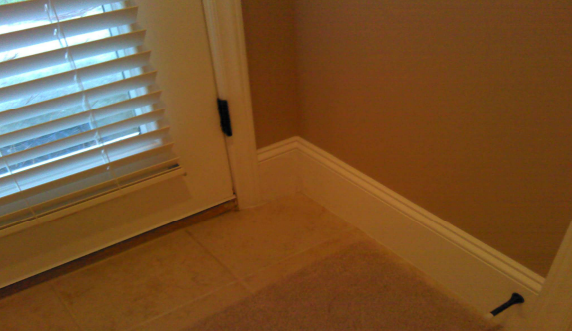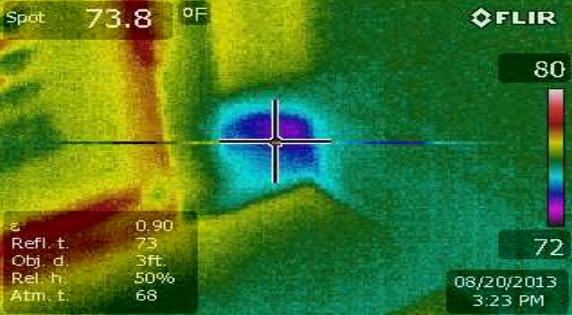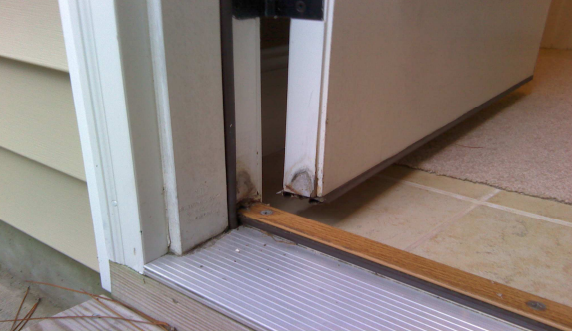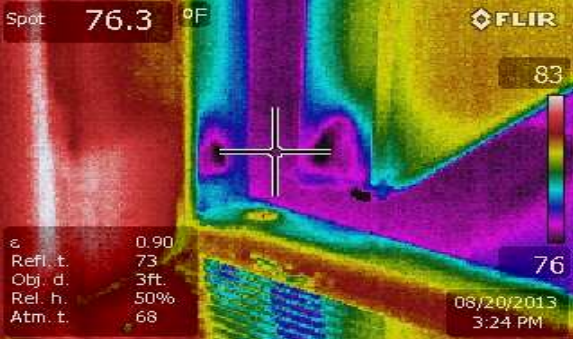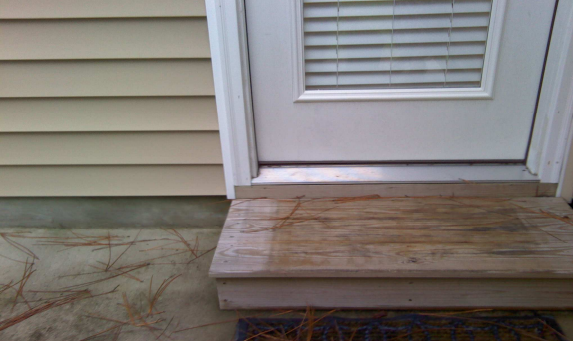Infrared Moisture
Picture #1: Interior photo of rear entry door hinge side and intersecting walls.
Picture #2: Infrared photo identifying moisture in baseboard and soleplate, dark blue and purple color illustrates cooler surface temperature indicating moisture is present. Flir moisture reading at this location was 50% in the baseboard and its surrounding sheetrock far exceeding acceptable moisture levels, if this level of moisture persists rot will be eminent. Red color running across threshold saddle and hinge side of doorjamb illustrate unconditioned outside air is leaking around doors weather striping and entering conditioned space of home.
Picture #3: Rear entry door opened exposing jamb and edge of door.
Picture #4: Dark blue and black color in the bottom edges of the doorjamb and bottom edge of door panel indicates moisture is present. Flir moisture reading showed 50% at this location far exceeding acceptable moisture levels. If this condition continues rot is eminent in door panel and door jamb.
Picture #5: Exterior side of subject rear entry door; aluminum threshold on left hand and hinge side of door unit is lower allowing storm splash water coming from valley above to be trapped against left hand jamb side of door unit and eventually entering into the interior side of the door and home. Splash water stains can be seen as high as two feet on the face of door unit and siding. Aluminum threshold appears to be bowed in the center adding to the negative slope towards the jamb. Rear door location is not in the best location considering the storm water run off from valley just above this entryway.
Recommendations:
1: Exterior door unit needs to be removed and reinstalled incorporating a seamless door pan with Vycor membrane wrapping doorjambs integrated into existing weather barrier and new door pan directing moisture to the outward side of the building envelope. Threshold needs to be solidly shimmed and slopped away from the home. Weather strip and threshold saddle need to be adjusted or replaced to reduce the transfer of outside elements entering around the door seal into the conditioned side of home.
2: Gutters need to be implemented above the rear entry patio area to capture roof and valley run off, downspouts installed should redirect captured storm water away from home and foundation.
3: The rear entry door being located directly under a main roof valley will always be a trouble area, even with a guttering system installed. Installing a quality grade storm door in combination with the gutters would aide in preventing wind driven over spill from heavy storm events reaching the rear entry door seals.
4: Roof diverters installed on valley area above rear door entry location may be useful during a light rainstorm, with the steep slope and sizable roof area above these two diverters heavy storm run off will wash over them rendering them useless under heavy storm conditions. The diverters are acting as a debris collector for the surrounding pine trees needles allowing a damning effect to take place. Trapped water in the valley at these diverters will allow for moisture to run under shingles and cause roof leaks through nails fastening asphalt shingles and diverters to the roof deck and possible rot could occur.


 910-395-5799 |
910-395-5799 | 